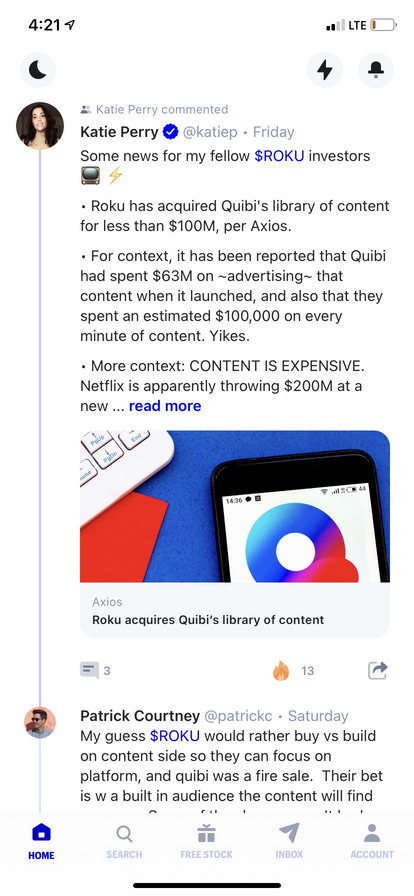Public Co-CEO Leif Abraham on FinTech Marketing, Using Values to Scale Decision Making, and Changing the Culture of The Stock Market
This article is part of Fintech Leaders, a newsletter with over 11,500 dreamers, entrepreneurs, investors, and students of financial services. I invite you to share and sign up here: Substack | LinkedIn Newsletter
“The stock market is scary because its culture is. To change the stock market you need to change its culture.”
What do you think of when you hear ‘stock trading’? For most of us in 2020, we thought of YOLO Calls, Tesla Bulls, Robinhood, and Day Trading. In earlier days, you might have thought of men in suits on the phone, scrambling to buy & sell questionable companies.
To help democratize investing to more people, the culture of the market needs to change. Enter Leif Abraham and Public.Com, the stock investing app with a social, community-based focus making stock trading approachable (and free) for everyday people.
My podcast Co-Host and good friend, Ryan Zauk, sat down with Leif to learn how Public is changing the market’s culture, but the episode soon transformed into a much deeper conversation about FinTech marketing, user retention, scaling decision-making, choosing values, and his hatred for the Davy DayTrader / Robinhood Bros.
Public has taken FinTech and social media by storm, raising $65M in a Series C this year backed by A list celebrities (Shaq, Tony Hawk, JJ Watt, Adrian Grenier) and VCs (Accel, Greycroft) who are also users of the platform.
Let’s break down the episode below:
Changing The Culture of The Market & Catering to New Investors
Public offers no-fee trading (equity only) to all types of investors, but is geared toward those that are new or underrepresented in investing. Leif talks extensively about his general disdain for Robinhood Bros and Davy DayTraders, and how unsettling investing can be for the average person.
It’s no secret that day trading is dominated by the white male bro stereotype, and Public is working to change that.
Public’s app is anchored on this “newsfeed feature” where people can share their investment ideas, results, and relevant news stories, and then engage in Q&A.
I have been using the app for a few months now, and have seen some awesome analysis from research analysts, professional traders, industry execs, twitter personalities, celebrities, VCs, and more.
These approachable figures from a variety of backgrounds, as well as an extremely collaborative culture, make it easy for people to get their feet wet and learn.
Leif points out how quickly people galvanize around causes, including a large group of investors who started investing in the only 4 Fortune 500 companies run by Black CEOs in the wake of the BLM movement this year. For those wondering, the companies are Lowes, TIAA, M&T Bank, and Merck.
Public has also put in educational notices, sparked by when a bankrupt Hertz was skyrocketing. If people on the app look to buy Hertz or similarly volatile investments, they get a warning explaining the severe risk involved. Safe to say this is a unique feature in investing apps…
What FinTech Marketing Gets Wrong
The marketing insights Leif provides in the episode are fantastic. On FinTech marketing specifically, he takes a couple jabs at MBAs (no offense taken), saying the MBA-mentality has infiltrated FinTech Marketing. FinTech startups over-index on features and rates that will not really resonate with most people, while completely ignoring the “mission,” “social,” and “emotional” decisions people make when choosing products.
Leif believes these execs are “diluting their own business model…competing in something that anyone can do.” People ultimately choose products with their hearts, which is why Public has seen great traction around ESG stocks. I strongly believe in Leif’s words here, as mission and identity-driven FinTechs continue to thrive.
Marketing Metrics To Focus On
All you hear today is growth growth growth, users, users, users, CAC, CAC, CAC.
Leif’s response?
“The easiest growth tactic you have is retention.” Leif is obsessed with customer retention — low customer churn leads to higher LTV, which means you can justify spending more money on acquistion. In addition, we talk about “K-Factor,” which is a measure of viral efficiency. Basically, for every customer you acquire, how many new customers do they bring in? Public has had extremely strong organic growth, and that has been the focus of most of their marketing efforts. Morning Brew has also done this extremely well, seeing significantly higher retention and activity from customers who were referred.
The Power of Evergreen Content Marketing & 90’s Boy Bands
Leif calls evergreen marketing “Asset Marketing.” The kind of content he loves to build is centered around advertisements and pages that will gain significant traction over the long-term. Think like a CPA building a free tax calculator on his website, Peloton putting ads on popular ab workout Youtube videos, etc. These sites will be searched in perpetuity and will consistently get traction over time.
What most advertisers do according to Leif is overpay for slots on the hottest trends and videos that will lose relevance in 1–2 weeks. Instead, he likes targeting a high volume of content at a lower price that will be used for years and years.
How is this like 90’s boy bands? “It’s like picking 90’s boy bands. Sure, 7 out of 10 may fail, but 3 out of 10 will be hugely successful.” Some fun real-life examples of asset marketing we talked about were Disney hosting and advertising on baby name websites and his friend building the “Tinder for Picking Baby Names.”
Instilling Strong Values
“When you build a company, you need to make tens of thousands of decisions, and as it scales, executives can’t keep making all of the decisions…a lot of companies fail not because they weren’t able to acquire users, but because they could not grow themselves as a company.”
Leif and I both offer our thoughts here (from the executive and employee perspective) on how to actually instill culture and values. Spoiler — having key values like “Diversity” “Service” and “Community” that just sit on an office wall are useless.
Actionable, tangible values are critical tools in a startup’s growth journey. Leif explains that these values act as guardrails for a company to scale, allowing decision making to be fueled by critical and creative thinking of more junior employees. His worst nightmare is people making decisions based on “What does my boss think is right vs. what do I think is right.” Leif and I talk about our positive and negative experiences with values, and how Public’s have allowed them to scale extremely effectively.
Our advice? Make them punchy and actionable, and frame all discussions around your values. These include 1 on 1 feedback sessions, team meetings, all-hands calls, and more. Public’s 10 values are below, and we spend the majority of our time on the first 2:
Honesty kills bullshit
Feedback comes from a place of care
Loyalty through care
Autonomy through alignment
Work fast through organized speeding
Urgency with charm
We are grown-ups
We don’t make excuses
What could go right?
Find a way
Ryan Zauk: This is one of my favorite episodes, hence why I wanted Miguel to get this to his audience. Enjoy the episode and I welcome all questions, feedback, and comments to @RyanZauk on Twitter.
Previous Episodes You May Enjoy:
Noah Kerner, CEO of Acorns - Leveling the Investment Playing Field
Frank Rotman, Founding Partner at QED Investors - Past, Present, and Future of Fintech!
Financial Literacy, Mocking Oprah, and Life Lessons with Neale S Godfrey
Future of Wealth Management and Investment Panel — Future of Banking Week
Anish Acharya, General Partner at Andreessen Horowitz - Doubling Down on Fintech
Redesigning the Asset Management Experience – Brian Barnes, Founder & CEO of M1 Finance
Leading Russia’s Fintech Innovation with Oliver Hughes, Tinkoff CEO
Miguel Armaza is Co-Host of the Wharton Fintech Podcast and Co-Founder of Gilgamesh Ventures, a seed-stage investment fund focused on fintech in the Americas.








